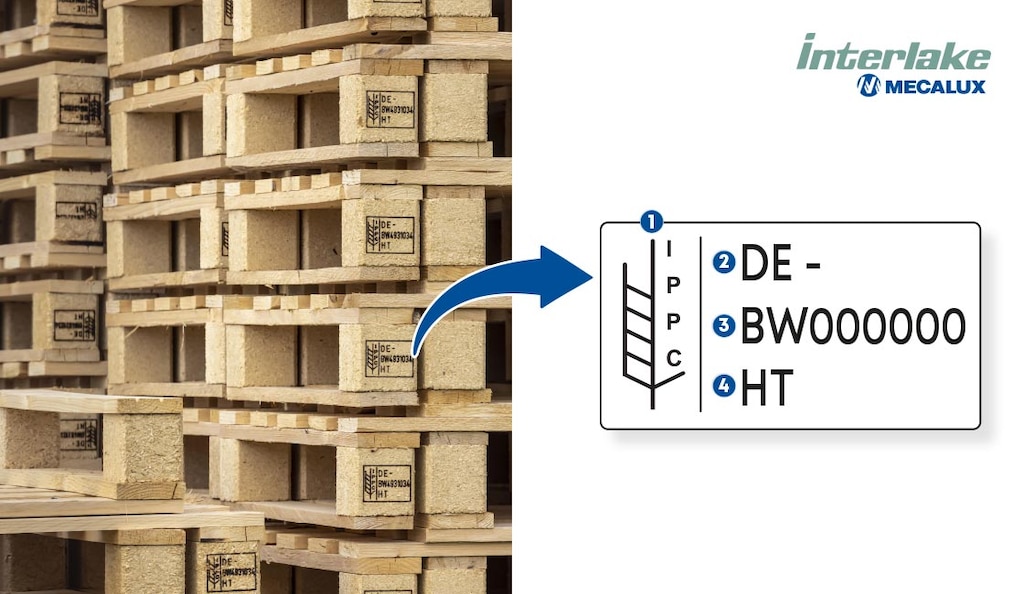
Pallet markings and codes: What do they mean?
Pallet markings via coding and colors are essential for ensuring traceability and regulatory compliance in international logistics operations. Every stamp, logo, and color serves a specific purpose, enabling businesses to track goods and handle them properly during transportation and storage.
Beyond that, pallet markings and colors help companies meet phytosanitary standards, simplify inventory management, and improve coordination among suppliers, distributors, and logistics service providers, making processes more efficient.
Treatment codes and regulatory stamps
Wooden pallets used in global trade must pass strict inspections to prevent the spread of pests and diseases. The IPPC stamp certifies that the wood has been treated according to international standards and includes information about the country of origin, method applied, and certifying body.
The phytosanitary codes below represent the most common types of treatment:
- HT (heat treatment). For pallets with the HT pallet stamp, the wood is heated until the core reaches a minimum temperature of 133 °F for at least 30 minutes.
- MB (methyl bromide). This chemical fumigant, which eliminates insects and larvae, is applied to the wood.
- KD (kiln dried). The wood is dried in industrial kilns to reduce moisture and kill living organisms.
- DB (debarked). This marking indicates that the bark has been removed, lowering the risk of infestation, though it doesn’t replace other treatments.
- SF (special fumigation). SF refers to additional or specific treatments required by certain countries or wood types.
Identification codes and abbreviations
Alongside phytosanitary stamps, pallet coding makes tracking, handling, and storage safer and more reliable:
- EUR/EPAL: Standardized Euro pallets certified by the European Pallet Association.
- UIC: Rail-transportation pallets built to UIC (International Union of Railways) specs, compatible with EUR logistics systems and train networks.
- GMA/CBA: North American standard for a 48" x 40" pallet, widely employed in the consumer goods sector. GMA stands for Grocery Manufacturers Association, rebranded as the Consumer Brands Association (CBA) in 2020.
- CP series (CP1–CP9): Utilized in the chemical and petrochemical industries, these markings indicate compliance with sector-specific transportation standards.
Pallet symbols and codes also help identify unit loads before they enter automated storage and retrieval systems (AS/RSs), where inbound inspection stations check pallet dimensions and quality.

Logos and ownership markings
Many pallets bear branded, painted, or stamped logos, especially in closed pooling systems, where companies rent pallets for reuse among authorized users. Below are some of the most common ownership markings.
- CHEP: The world’s largest pallet pooling service is known for its blue pallets and distinctive logo.
- LPR: Red logo of La Palette Rouge, common in Western Europe and fast-moving consumer goods (FMCG) logistics operations.
- IPP: These pallets belong to the IPP Pooling network from Faber Halbertsma Group (FHG). Recognizable by their brown color, they’re increasingly utilized in several markets.
Other regional or industry-specific brands include:
- PECO: North American pooling provider primarily used in FMCG distribution.
- Loscam: Prominent in the Asia-Pacific region, specializing in pallet and container pooling.
- PRS: Identified by green stripes, the Pooling Partners Reuse System serves the chemical and petrochemical sectors within FHG.
- iGPS: Plastic pallets with RFID technology for real-time tracking and traceability.
Industry-specific markings
Certain pallets feature additional markings depending on the sector, facilitating safety and compliance:
- Recycling marks: Show that the pallet is reusable or recyclable, supporting sustainable supply chains.
- FSC and PEFC certifications: Guarantee that the wood comes from responsibly managed forests.
- Pharma and chemical industry labels: Identify pallets approved for sensitive or regulated goods, such as those in the CP series.
These markings improve operational efficiency, enhance safety during transportation, and help companies meet industry regulations while promoting sustainable practices.
Pallet color meaning
Color is a quick way to identify pallet ownership or purpose, both outdoors and in warehouses. Visual codes usually indicate pallet ownership or the pooling provider:
- Blue: Associated with CHEP’s globally recognized pallets.
- Red: Used by PECO in the US, LPR in Europe, and Loscam in Asia-Pacific.
- Brown: Characteristic of IPP for easy tracking within its network.
- Gray: Occasionally employed by European recyclers.
- Yellow: Sometimes marks returnable pallets within local systems.
Colors such as yellow, orange, and red also serve intralogistics purposes. For instance, they can:
- Signal hazardous materials.
- Mark specific warehouse zones.
- Indicate pallet life cycles (new, repaired, or retired).
- Assign pallets to specific clients or production lines.
Proper pallet color coding supports fast identification and minimizes handling errors.
Regional differences
Pallet markings and colors vary worldwide, depending on local standards, industries, and pooling providers:
- US. Most pallets follow the GMA/CBA standard. Closed-pool pallets are marked with operators’ colors and logos (e.g., CHEP and PECO).
- Europe. Common types include EUR/EPAL pallets, the CP series (CP1–CP9) for chemicals, and UIC pallets for rail transportation.
- Asia-Pacific. Pallets managed by Loscam and CHEP Asia are widely used in international trade and industrial logistics operations.
- Latin America. This market features a mix of EPAL and national markings aligned with local legislation.
Understanding these differences helps companies plan cross-border operations, guarantee compatibility with storage systems, and comply with global regulations.

Pallet markings: Key for logistics operations
Pallet markings aren’t just decorative details — they’re vital to global logistics management. Knowing what pallet stamps, codes, and colors mean allows businesses to speed up processes, stay compliant, and avoid costly mistakes. A clear and consistent pallet identification system also reduces handling errors, prevents losses, and fosters sustainability through better reuse and life cycle control.
Pallet markings in 5 questions
What are pallet markings?
Pallet markings are stamps, codes, or logos applied to pallets to identify their ownership, origin, treatment, and characteristics. They enable compliance with phytosanitary and industry regulations, simplify management in closed pools, and help optimize goods handling, storage, and transportation.
What types of pallet marking are there?
There are several types of markings: phytosanitary (e.g., the IPPC stamp), standard pallet codes (EUR/EPAL or GMA/CBA), ownership logos (CHEP or LPR), and sector-specific markings (food symbols, recycling logos, FSC/PEFC certifications, or pharmaceutical and chemical labels).
Are there differences between pallet markings in the US and Europe?
Yes. In the US, GMA-standard pallets and pooling provider colors, such as CHEP’s, are predominant. Europe, meanwhile, employs EUR/EPAL, CP series, and UIC codes. These differences affect compatibility, transportation, storage, and management in international pools, so understanding them is critical for efficient cross-border trade.
Why are some pallets blue, red, etc.?
Pallet coding by color indicates ownership, provider, or condition. For example, pallets may be blue (CHEP) or red (LPR). Colors are also utilized for signaling: yellow or orange can denote hazardous materials, life cycle stages, or client allocation.
What is the IPPC pallet stamp?
The IPPC (International Plant Protection Convention) stamp certifies that the wood used in the pallet has undergone a universally recognized phytosanitary treatment. It indicates the country of origin, type of treatment, and certifying body, ensuring compliance with import regulations, preventing pest spread, and contributing toward safe international logistics operations.
